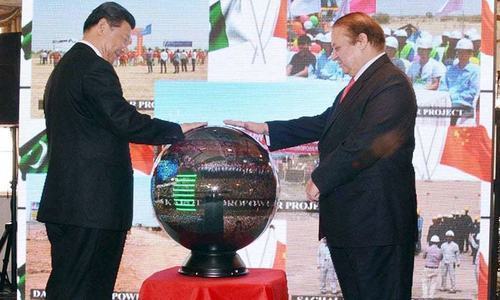A keen businessman who has been hurt badly by his own miscalculations in the past, the prime minister seems to have done a detailed cost-benefit analysis of his power enterprise this time around and looks determined not to set a foot wrong. But will he be able to pull it off?
Let’s start by looking at his astute numbers game and some of his political moves as he completes half his current term in office. After the last general election, Mr Nawaz Sharif seems to have quickly done the numbers and realised all he needs to sustain himself in power is a large number of seats in the largest province of the country with a sprinkling in the other three provinces.
It wasn’t surprising, therefore, to see him conceding provincial government-making to other parties in the provinces even though in one case a numerical possibility existed for the PML-N to try and form an administration.
The PM’s biggest provincial autonomy test will be CPEC.
That he made this concession because he said he was a democrat and thus committed to letting bigger winners in each case lead the process made him appear magnanimous. He was content to let his younger brother take charge of Punjab and to deliver those high-profile projects that mattered most to his long-term political longevity.
Here, he may have wanted to steam ahead like in his last tenure cut short by a military coup. But whatever the desired final goal of Imran Khan’s dharna may have been, the protests achieved one purpose: the clipping of the prime minister’s wings.
The prime minister was forced to share, even surrender, policy decision-making in key areas such as national security and large swathes of the foreign policy to the military and seemed to have reconciled to his limitations rather quickly. He happily plays second fiddle perhaps in the knowledge he’ll outlast every other player and will call all the shots one day if he plays his cards right.
Initially, the prime minister also appeared to be a keen believer in provincial autonomy and committed to enhanced provincial rights contained in the 18th Amendment. However, as a couple of key tests come up, it isn’t clear if the prime minister’s definition of national interest is compatible with the provinces’.
The military-led operation in Karachi and what it has delivered to the city in terms of cuts in violent death statistics cannot be denied. Everyone one talks to in the metropolis seems to be breathing easier when viewed against the backdrop of the situation of just a couple of years ago.
But the Sindh government has raised serious objections to certain aspects of the operation in Karachi whereby, it feels, the provincial autonomy provisions of the Constitution are being ignored. The prime minister has chosen not to address these concerns.
There is no doubt in any impartial observer’s mind that governance in Sindh leaves a lot to be desired with mismanagement and corruption two major issues. The governing PPP so far appears to have given no indication it is capable of improving in either area.
It is equally true that till the governing party enjoys the support of the majority in the Sindh Assembly it needs to be allowed to rule as long as the centre cannot question its viability on the basis of a total breakdown of the rule of law. Even then a valid case will have to be made for governor’s rule before the Supreme Court of Pakistan.
It would also serve the cause of equal treatment to all provinces if the National Accountability Bureau, chaired by a Sharif loyalist, could initiate even perfunctory investigations against politicians/functionaries in Punjab too. NAB’s struggle to initiate even a single probe here is giving the impression the province is as clean, corruption-free and above board as its ideal Saudi Arabia.
Another element which may create the aura of even-handed enforcement of the law would be the manner in which the Punjab police are asked to investigate, for example, rape cases involving PML-N office-bearers in one way or another.
Whether in Kasur or more recently in Lahore the emphasis has been on demonising the victim/survivors and blaming the crime on property disputes rather than bringing the perpetrators to justice.
But the gravest provincial autonomy test the PML-N and Sharifs face will be in their handling of the China-Pakistan Economic Corridor-related issues: it turns out the ‘western corridor’ project the prime minister recently opened in Balochistan was no more than an ADB-funded road improvement, hardly fitting the definition of a CPEC corridor.
It is incumbent on the federal government to convince Balochistan and KP that the ‘P’ in CPEC stands for Pakistan and not for a province that forms the PML-N’s power base.
The writer is a former editor of Dawn.
Published in Dawn, January 9th, 2016













































